Flambeau Mine, Rusk Co, WI Minerals and More
Jul 10, 2018 12:02:08 GMT -5
1dave, hummingbirdstones, and 2 more like this
Post by fernwood on Jul 10, 2018 12:02:08 GMT -5
The Flambeau mine was located in Rusk County, Wisconsin.
Ore shipments from the site began in May 1993 and continued for just over 4 years. Backfilling of the pit took about 1.5 years and reclamation activities at the site were generally completed by the end of 1999.
The 181-acre mining site located about one mile south (edit from article, about 3 miles South) of Ladysmith, Wisconsin, is bounded on the east by State Highway 27 and on the west by the Flambeau River.
The Flambeau deposit existed at very shallow depth. Depth to bedrock at the mining site ranged from about 15-40 feet. Glacial sand, gravel and till overlaid sporadically occurring Cambrian sandstone which in turn sat above the weathered pre-Cambrian metamorphic rocks containing the Flambeau deposit.
Mining of this shallow ore body was accomplished through a 32-acre open pit. The pit trended in a northeast-southwest direction and was 2,600 feet long, about 550 feet in width, and reached an ultimate depth of about 220 feet. (Personal note: Local divers have been in the Flambeau River bordering the mining site since mining started. The mine stopped just shy of the river. Divers have found some amazing specimens there. Some used hand tools for digging).
Over the course of the mining operation, about 1.9 million tons of ore containing about 8.9% copper and 0.10 ounces of gold per ton were mined and shipped from the site. The mine produced about 178,000 tons of marketable copper and 328,000 ounces of gold.
• Metals: 181,000 tons of copper, 334,000 ounces of gold and 3.3 million ounces of silver.
• Waste rock: Approximately 4.5 million tons of high sulfur waste rock and 4 million tons of low
sulfur waste were generated and stockpiled on site for eventual return to the pit.
Note that exact totals for above minerals vary considerably. Based on the almost constant trains leaving the site at the peak of production, many feel the above numbers are not accurate. Reportedly, only ore rich in minerals, were being removed via train. All other debris, was stockpiled on site for the eventual reclamation process.
The loaded trains often left at night, but sometimes during the day. The train cars were usually black and covered. There were usually no markings on the cars other than a few numbers. Each car often had armed security guards standing at both ends. This has led some people to believe that the Flambeau mine was not the publicized copper mine, but a gold mine. The largest figure above amounts to only just under 21,000 pounds of gold mined. At that time, gold was at just under $300.00 per ounce. So, there was officially about 6.3 million dollars of gold mined.
Enjoy the photos and descriptions of the other minerals found at the Flambeau mine. I will get back to the gold later.
I have left out the obvious minerals, gold, copper and silver. The below info was copied from the Wisconsin Geological and Mineral Survey internet site.
RUSK COUNTY: Schists associated with the massive sulfide Flambeau deposit near Ladysmith contain andalusite as light gray porphyroblasts averaging that can be up to 10 cm. long associated with biotite, chlorite, quartz, pyrite and sericite (May,1977; Cordua, 1994 field obs.).
— Andalusite is a component of the meta-sedimentary rocks at the Eisenbrey massive sulfide deposit north of Ladysmith (NW sec. 17 T.35N. R.6W. (May, 1996).
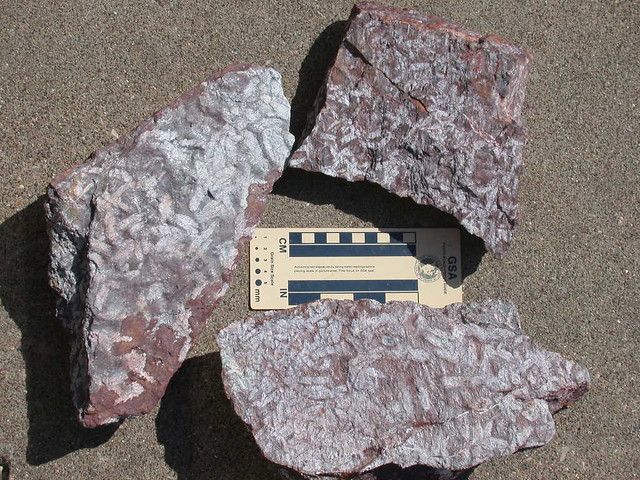 andalusite
andalusite RUSK COUNTY: Forms as acicular crystals on calcite in the carbonate zone at the Flambeau Mine, near Ladysmith.
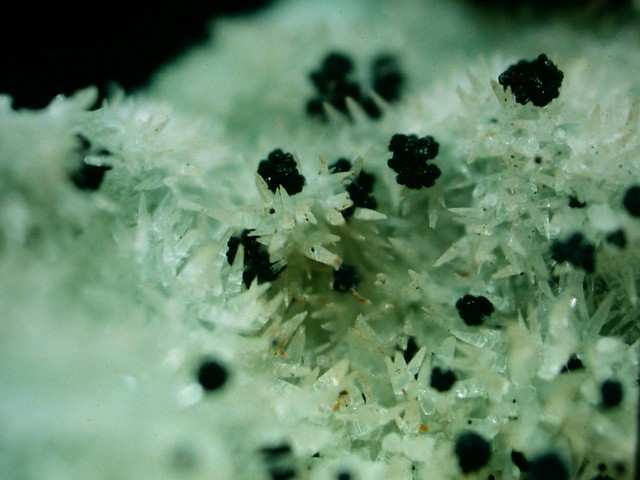 aragonite
aragonite found as euhedral crystals, at times several centimeters across in the Flambeau Copper Mine, near Ladysmith. Some samples labeled as arsenopyrite, however, have later been shown upon analysis to be marcasite with little or no arsenic. Energy-dispersive spectroscopy (EDS) does verify some arsenopyrite in pockets with chalcocite crystals associated with bornite, quartz, and pyrite. (Tom Buchholz, 2002, 2016, pers. com.)
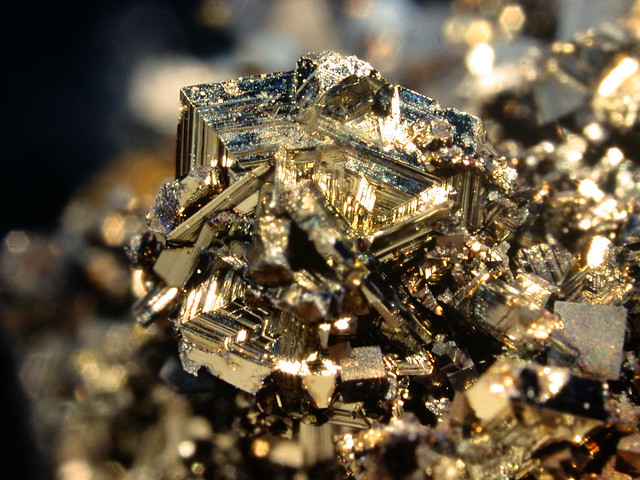 arsenopyrite
arsenopyrite RUSK COUNTY: Found as massive to drusy crusts and botryoidal masses in the gossan zone overlying the Flambeau massive sulfide deposit south of Ladysmith. Some crystal cluster form rosettes up to 2 cm. across associated with malachite, cuprite, tenorite and native copper (May, 1977; Rosemeyer, 1995 and 1997). Azurite
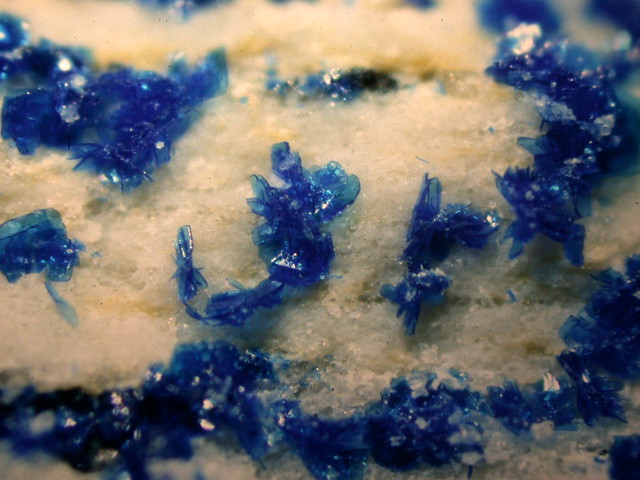 azurite
azurite RUSK COUNTY: Beaverite occurs as in the oxidized zone at the Flambeau Mine, near Ladysmith (Jones, Jones, and LaBerge, 1999).
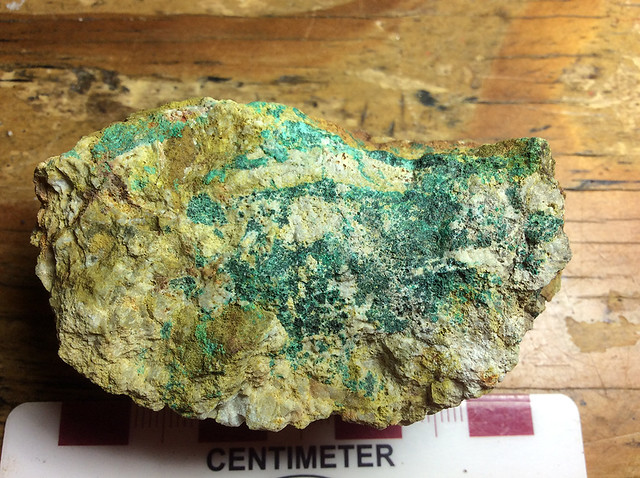 beaverite
beaverite RUSK COUNTY: Bornite is a major component of the supergene enrichment zone at the Flambeau deposit, south of Ladysmith in T.34N R.6W. It is found as masses and veinlets where it replaces chalcopyrite and is in turn replaced by chalcocite (May, 1977). During mining it was found in pure masses of considerable size intergrown with chalcopyrite and chalcocite. The bornite also coats large chalcocite crystals giving them a distinctive purple, blue, yellow or green patina.
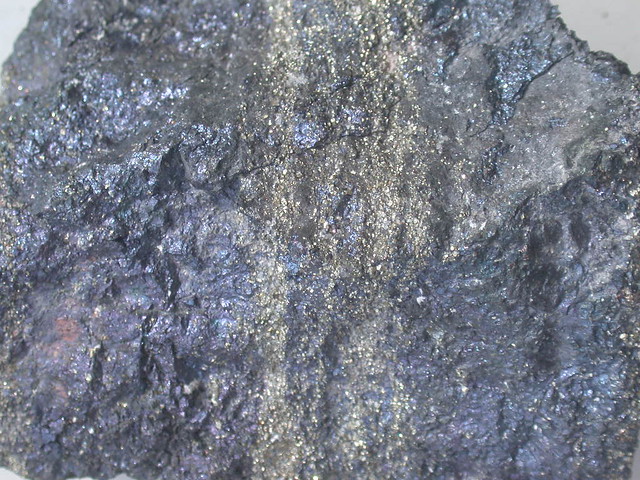 bornite
bornite Calcite
RUSK COUNTY: Carrollite has been tentatively identified as silvery black crystals on dolomite from the carbonate zone of the Flambeau Copper Mine, near Ladysmith. (Buchholz, personal communication)
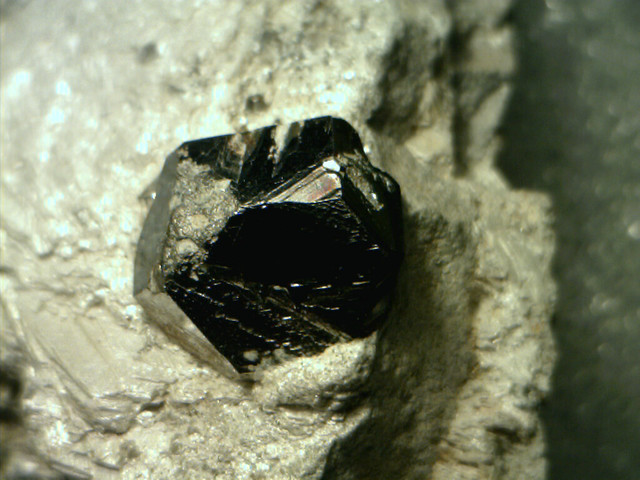 carrolite
carrolite RUSK COUNTY: Sky blue coatings of chalcanthite were abundant as post-mining deposits on rock surfaces in the Flambeau Mine, Ladysmith (Cordua, field notes).
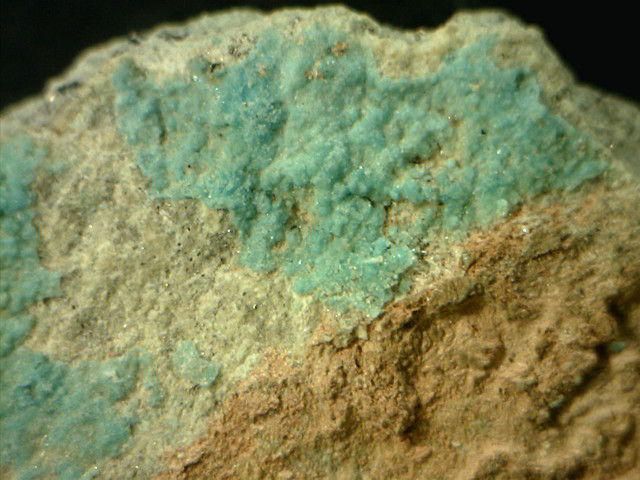 chalcanthite
chalcanthite RUSK COUNTY: Chalcocite was abundant at the Flambeau Mine, sec. 9 T.34N. R.6W., south of Ladysmith, where it occurred in a wide variety of habits, some of world-class specimen quality. It was found generally as sooty to coarsely crystalline granular masses in the supergene zone, where it formed one of the mine’s primary ore materials. It was associated with chalcopyrite, malachite, azurite, bornite and pyrite. Crystallized chalcocite was frequently encountered in cavities. Occasionally pockets several cubic meters in size would form at the intersections of fractures, along water courses active during supergene enrichment. The walls of these cavities were generally lined with curving or botryoidal growths, tending to be locally skeletal or stalactitic in nature. A later generation of euhedral xls., some individuals several centimeters long were perched on these. Most of the crystals were cyclically twinned on (110), giving pseudohexagonal symmetry. More rarely, X-shaped twins on (112) or (032) were found. Clusters often showed these crystals in parallel growth. Many specimens had a thin coating of bornite which imparted an attractive iridescence in shades of purple, brassy, bronze, green or blue. A number of crystals were partially or completely replaced by chalcopyrite and bornite, probably as a result of water table fluctuation. Some have parting that is likely the result of polysynthetic twinning. A number of fine specimens were preserved due largely to the efforts of a contract collector, Mr. Casey Jones. Jones assigned names to the larger vugs such as the Drill Pocket, Lucky Friday Pocket, Sunset Pocket and Quick Pocket. Excellent specimens have made their way into museum and private collections. A number of the best specimens are illustrated in LaBerge, 1997. (May, 1973; Cordua, 1994- 1997 pers. obs.; LaBerge, 1997; Jones and LaBerge, 1997).
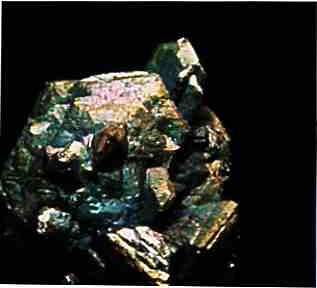 chalcocite1
chalcocite1 RUSK COUNTY: Common component of the massive sulfide ore body at the Flambeau deposit near Ladysmith. It is especially common toward the hanging wall, when it forms masses interstitial to pyrite up to 5 cm. across. It is also found in veins cross-cutting the massive sulfide zone and as a late generation supergene mineral. These late coatings often occur as botryoidal-like coatings on primary chalcopyrite or as micro-tetragonal crystals on bornite. (May, 1977).
— Chalcopyrite is a major ore mineral in the Eisenbrey massive sulfide body north of Ladysmith (NW sec. 17 T.35N. R. 6W.).It is associated with pyrite, pyrrhotite and sphalerite. (May, 1996).
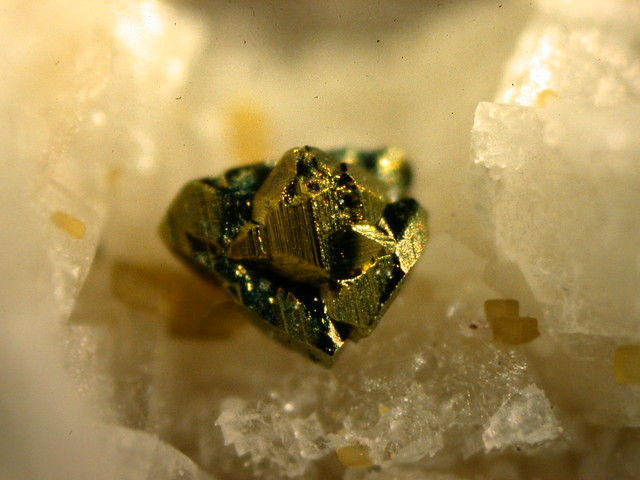 chalcopyrite
chalcopyrite RUSK COUNTY: Common component of schists associated with sericite. andalusite, biotite, quartz and spessartine in the Flambeau Copper Mine south of Ladysmith (May, 1977). Chlorite
RUSK COUNTY: Chrysocolla and related cupriferous clays occurred in the oxidized zone at the Flambeau Mine, near Ladysmith. The chrysocolla formed blue, green, yellow and ocherous masses and coatings on other copper minerals.
 chrysocolla
chrysocolla RUSK COUNTY: Cordierite-makes up as much as 20% of the matrix of the quartz-eye schist at the Flambeau deposit Sec. 9 T.34N R.6W, south of Ladysmith (May, 1977).
— Occurs with anthophyllite in metamorphosed iron formation at the Eisenbrey massive sulfide deposit, north of Ladysmith (NW sec. 17 T.35N. R.6W.) May form poikiloblasts. (May, 1996).
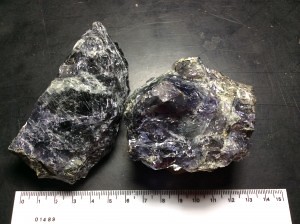 Cordierite-300x224
Cordierite-300x224 RUSK COUNTY: Crandallite-florencite occurs as a tiny euhedral xls. in a meta-saprolite horizon separating the Barron quartzite from the underlying meta-tonalite. This is exposed on the south bank of Weigor Creek, NW SW sec. 9, T36N R7W. (Medaris, 2000).
— Crandallite is reported at the Flambeau Mine, near Ladysmith. (Jones, Jones and LaBerge, 1999)
 crandallite
crandallite RUSK COUNTY: Massive, octahedral and acicular red crystals (“chalcotrichite”) occur as a minor component of the oxidized zone over the Flambeau ore deposit near Ladysmith (May, 1977, Rosemeyer, 1995, 1996).
 cuprite1
cuprite1  cuprite2-300x225
cuprite2-300x225 RUSK COUNTY: Digenite occurred with chalcocite in the Flambeau Mine, near Ladysmith. (Casey Jones, personal communication)
 digenite
digenite RUSK COUNTY: Dzhalindite occurs as microscopic black grains with chalcocite at the Flambeau Mine, near Ladysmith (Jones, Jones, and LaBerge, 1999).
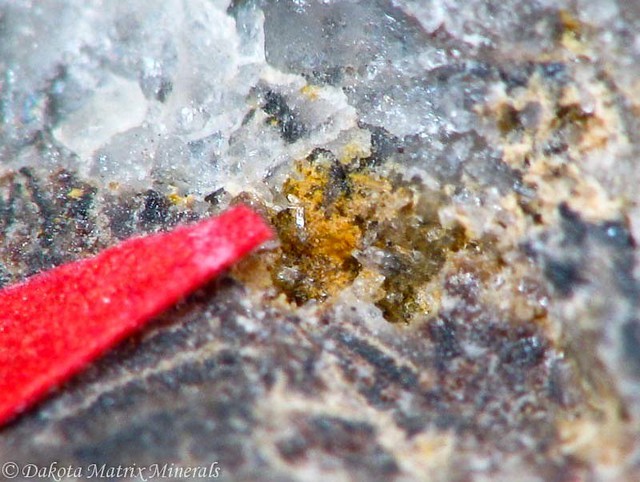 dzhalindite
dzhalindite RUSK COUNTY: Ferristrunzite is found as bright yellow acicular crystals arranged in radial clusters in vugs and seams in massive cuprite/goethite with quartz at the Flambeau Mine, near Ladysmith. Verified by EDS and X-Ray analysis. (Buchholz, personal communication)
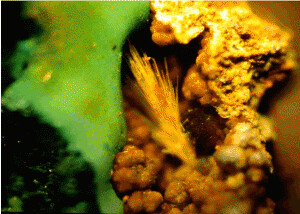 ferristrunzite-300x214
ferristrunzite-300x214 RUSK COUNTY: Tiny green xls found at the Flambeau Copper Mine south of Ladysmith associated with tetrahedrite-tennanitite were tentatively identified as gahnite after SEM-EDS analysis. (Tom Buchholz, 1997, personal communication
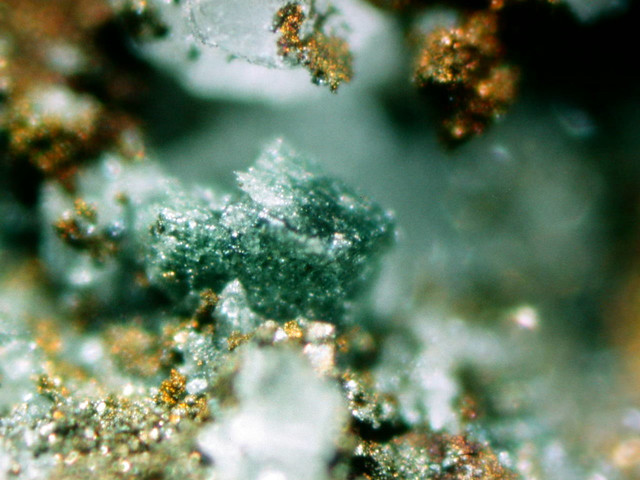 gahnite
gahnite RUSK COUNTY: Occurs either as pseudo-isometric crystals or as coatings on or pseudomorphs after pyrite, from the Flambeau Copper Mine, Ladysmith. ( Dan Behnke, personal communication) Glaucodot
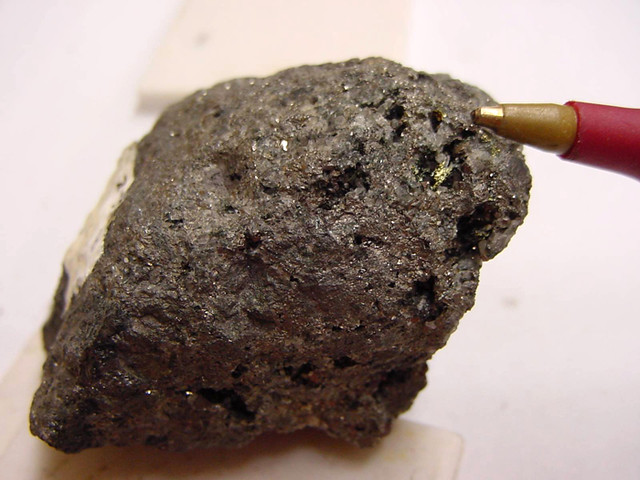 glaucodot-andrew-silver
glaucodot-andrew-silver RUSK COUNTY: Gypsum crystals occur with dolomite, ankerite and sulfides in a carbonate zone within the Flambeau Copper Mine, Ladysmith. (Cordua, field notes).
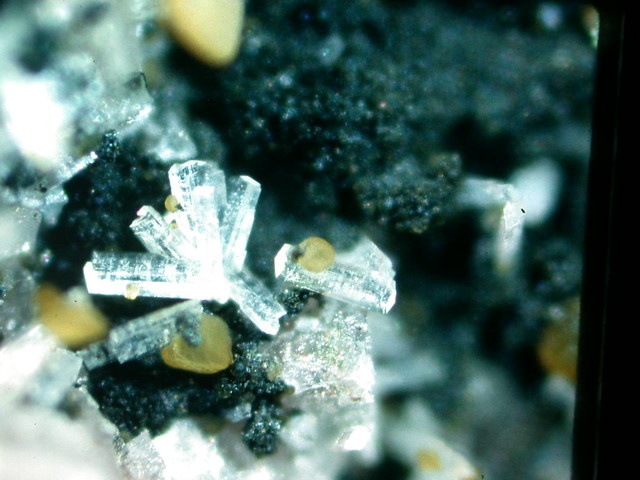 gypsum
gypsum RUSK COUNTY: White fibrous crystals of halotrichite were abundant as post-mining deposits on rock surfaces in the Flambeau Mine, Ladysmith. (Cordua, 1995, field notes).
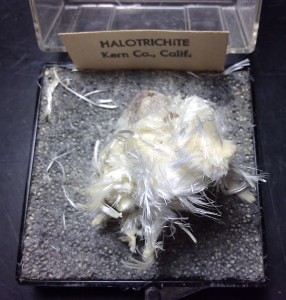 Halotrichite-286x300
Halotrichite-286x300 RUSK COUNTY: Hematite is a component of the gossan cap with other secondary iron and copper minerals at the Flambeau deposit, near Ladysmith (May, 1977).
RUSK COUNTY: Hessite was reported as tiny grains intergrown with other sulfides in the primary ore at the Flambeau Copper Mine, Ladysmith ( May and Dinkowitz, 1996).
 hessite-norman_king
hessite-norman_king RUSK COUNTY: Hidalgoite occurs in the oxidized zone at the Flambeau Mine, near Ladysmith. (Jones, Jones, and LaBerge, 1999).
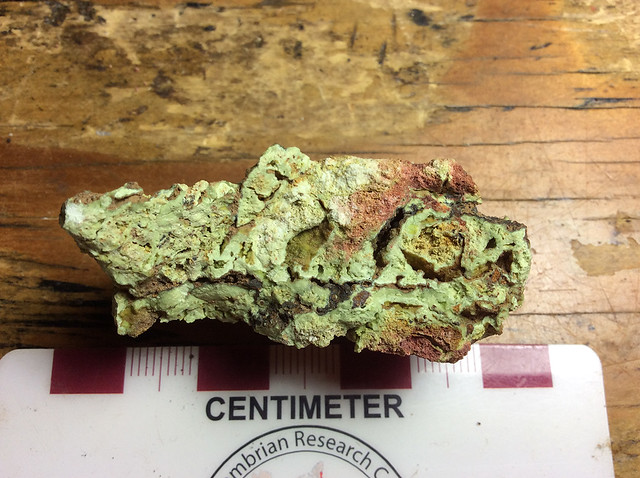 hidalgoite
hidalgoite RUSK COUNTY: Kemmlitzite occurs in the oxidized zone at the Flambeau Mine, near Ladysmith (Jones, Jones, and LaBerge, 1999).
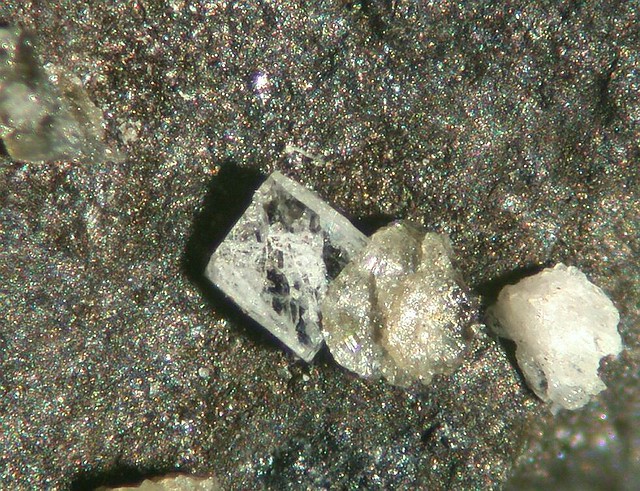 kemmlitzit-elmar_lackner
kemmlitzit-elmar_lackner RUSK COUNTY: Kolbeckite was found as lime green micro-xls on sooty chalcocite in the Flambeau copper mine, south of Ladysmith (Rosemeyer, 1995, 1996).
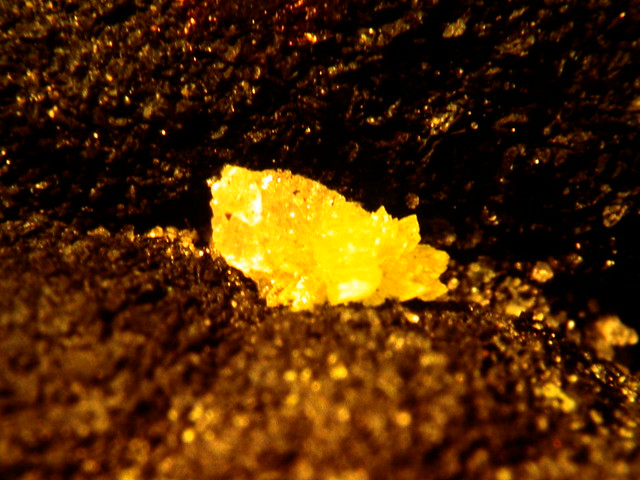 kolbeckite
kolbeckite RUSK COUNTY: Leucophosphite occurs as microscopic pale brown platey crystals and crystal rosettes in oxidized ore at the Flambeau Copper Mine, near Ladysmith (Buchholz, personal communication).
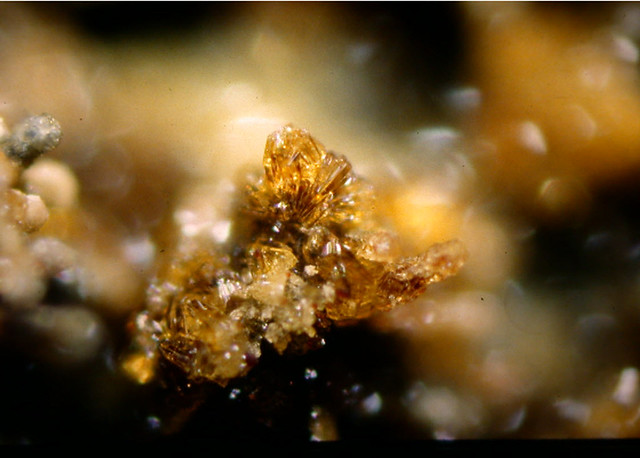 leucophosphite
leucophosphite RUSK COUNTY: Malachite occurs at the Flambeau Copper Mine, south of Ladysmith (Sec. 9 T.34N. R.6W.) in the supergene and oxidized zones. It occurs as coatings and masses. The masses may be vuggy with botryoidal, fibrous or drusy malachite associated with azurite and other rare copper minerals. Interesting coiled, ringed or helical growths may occur (May, 1977, Rosemeyer, 1995, 1997).
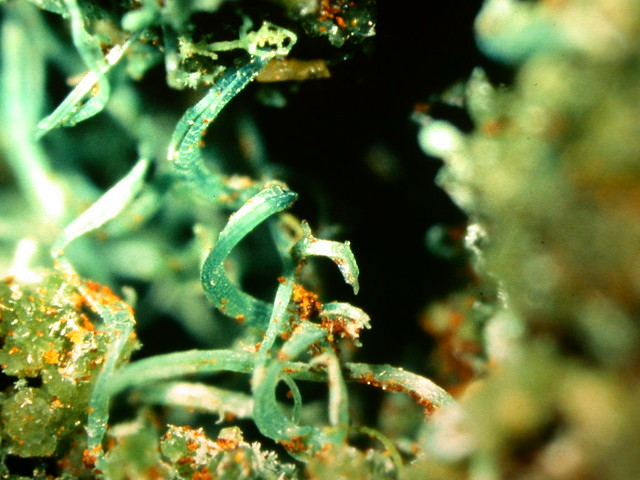 malachite
malachite RUSK COUNTY: Marcasite crystals and clusters occur in vugs with dolomite in the carbonate zone at the Flambeau Copper Mine south of Ladysmith.
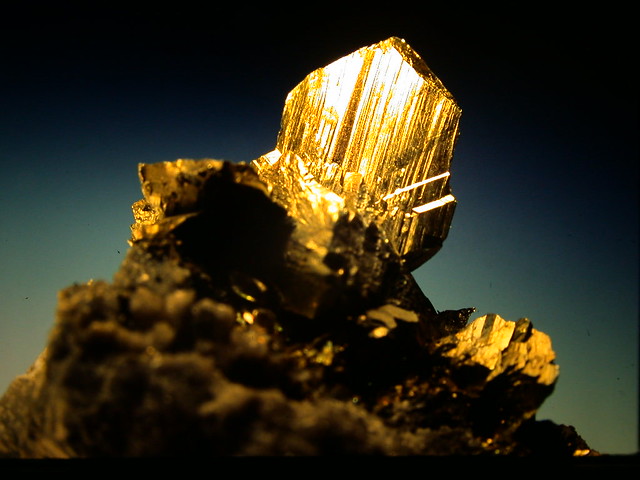 marcasite1
marcasite1 RUSK COUNTY: Forms dark to pale green crystals and coating on vivianite from the oxidized zone, Flambeau Mine, near Ladysmith. (T. Buchholz, pers. comm.) Metavivianit
 marcasite1
marcasite1 RUSK COUNTY: Osarizawaite occurs in the oxidized zone at the Flambeau Mine, near Ladysmith (Jones, Jones, and LaBerge, 1999).
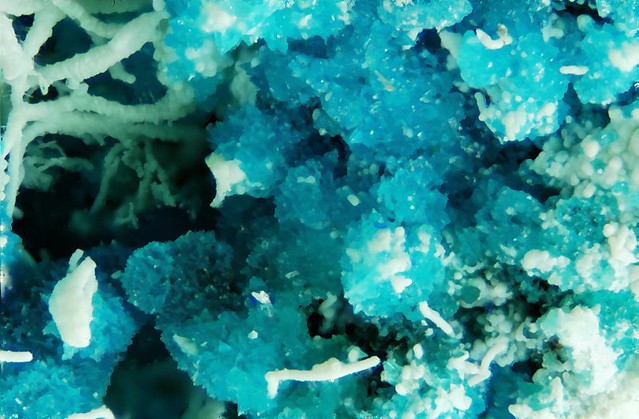 osarizawaite-jesse_crawford
osarizawaite-jesse_crawford RUSK COUNTY: Petzite is reported as a component of the ore at the Flambeau Mine, south of Ladysmith (Jone, Jones, and LaBerge, 1999)
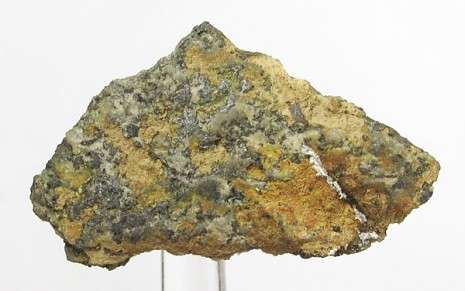 petzite-rob_lavinsky
petzite-rob_lavinsky RUSK COUNTY: Plumbogummite occurs in the oxidized zone at the Flambeau Mine, near Ladysmith (Jones, Jones, and LaBerge, 1999).
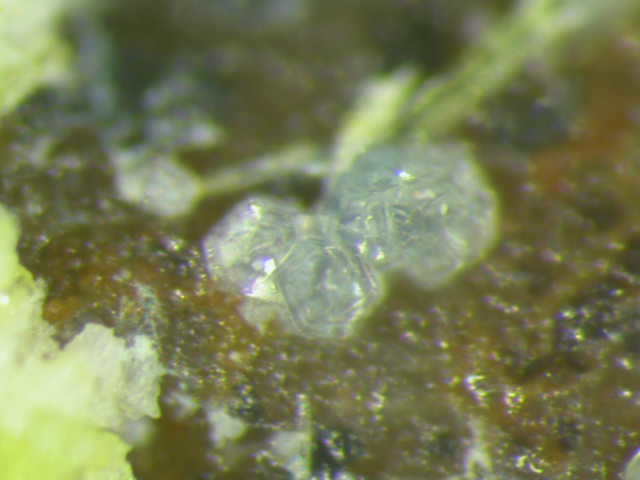 plumbogummite-brent_thorne
plumbogummite-brent_thorne RUSK COUNTY: Pseudomalachite occurs as rare masses and spherical rosettes of drusy crystals in the oxidized zone of the Flambeau Mine, Ladysmith (Buchholz, personal communication).
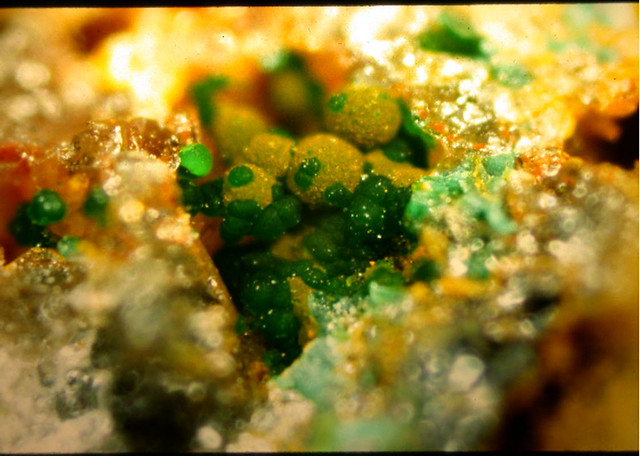 pseudomalachite
pseudomalachite RUSK COUNTY: Quartz as massive to vuggy blocks in gossan and as bluish “eyes” in schist occur at the Flambeau Mine south of Ladysmith (May, 1977).
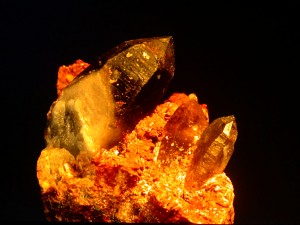 quartz-on-feldspar-300x225
quartz-on-feldspar-300x225 RUSK COUNTY: Rutile is reported at the flambeau Copper Mine near Ladysmith. (Jone, Jones and LaBerge, 1999)
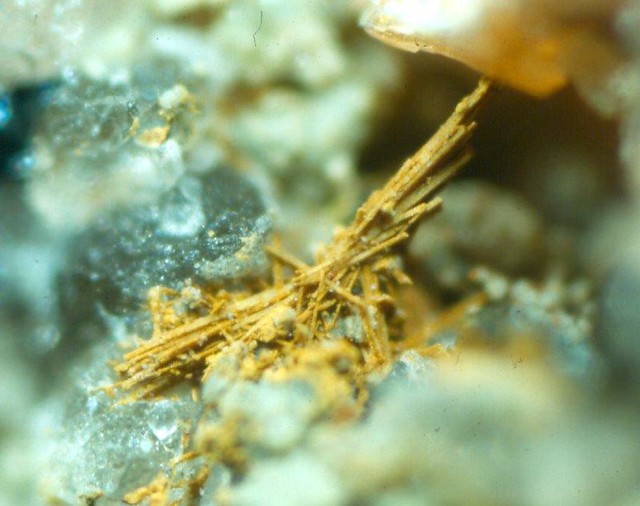 rutile-1.2mm
rutile-1.2mm RUSK COUNTY: Siderite is a heavy mineral in the Barron Quartzite ,as exposed in Rusk and adjacent Sawyer Counties (Ernst and others, 1980). As yellow crystals on dolomite. From Flambeau Mine in Rusk County, Wisconsin.
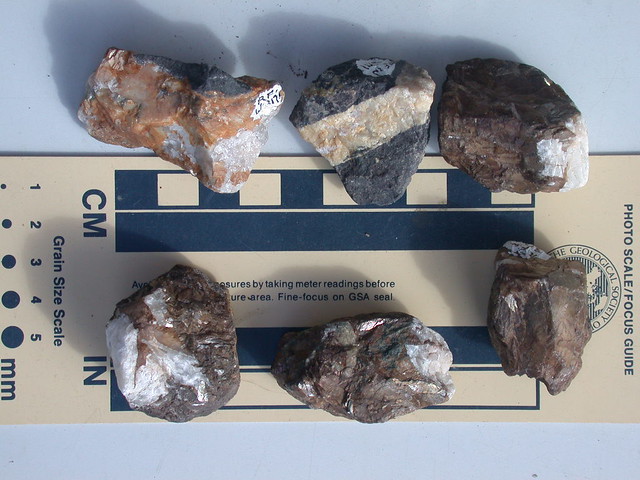 siderite21
siderite21 RUSK COUNTY: Spessartine occurs as small dodecahedral porphyroblasts in chlorite schist at the Flambeau Mine, Sec. 9 T.34N. R.6W. (May, 1977).
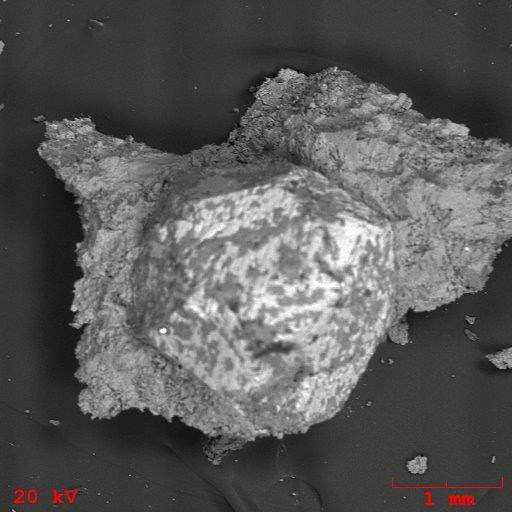 Spessartine by Fernwood Acres, on Flickr
Spessartine by Fernwood Acres, on FlickrRUSK COUNTY: Sphalerite is a component of the massive sulfide ore at the Flambeau deposit near Ladysmith. The sphalerite tends to be more common toward the footwall portion of the deposit. The sphalerite is intergrown with pyrite and is often banded ranging from dark brown to honey brown in color. some dark brown euhedral sphalerite xls were found in a vuggy carbonate zone, with dolomite, siderite and other sulfides (May, 1977; Rosemeyer, 1995, 1996).
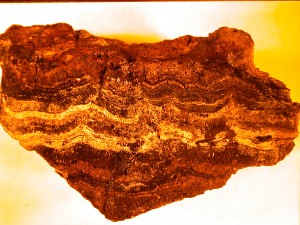 sphalerite-2-300x225
sphalerite-2-300x225 RUSK COUNTY: Tenorite forms earthy botryoidal coatings, specks and masses in the gossan zone of the Flambeau Mine massive sulfide deposit, south of Ladysmith (May, 1977).
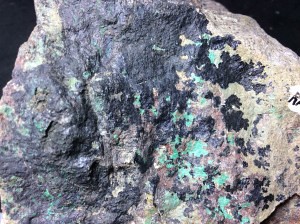 Tenorite-2-300x224
Tenorite-2-300x224 RUSK COUNTY: Tetrahedrite-tennantite occur as euhedral xls. with pyrite, chalcopyrite and other sulfides in the vuggy zones in the Flambeau copper mine near Ladysmith. (Rosemeyer, 1996).
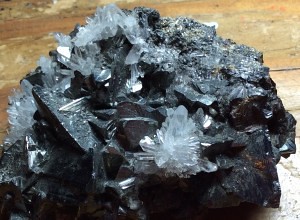 Tetrahedrite-tennantite-300x220
Tetrahedrite-tennantite-300x220 RUSK COUNTY: Bladed clusters of tiny crystals of a deep green color were found in the oxidized zone of the Flambeau Copper Mine, near Ladysmith. (Buchholz, pers. com.) Vivianite
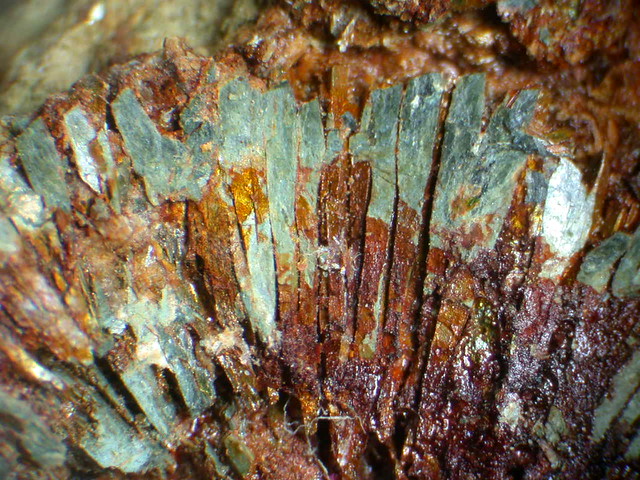 Vivianite
Vivianite RUSK COUNTY: Small black masses of wittichenite were found in quartz, siderite and copper sulfides at the Flambeau Copper Mine near Ladysmith. Identity verified by EDS and in-situ XRD, courtesy of Mike Wise, Smithsonian.
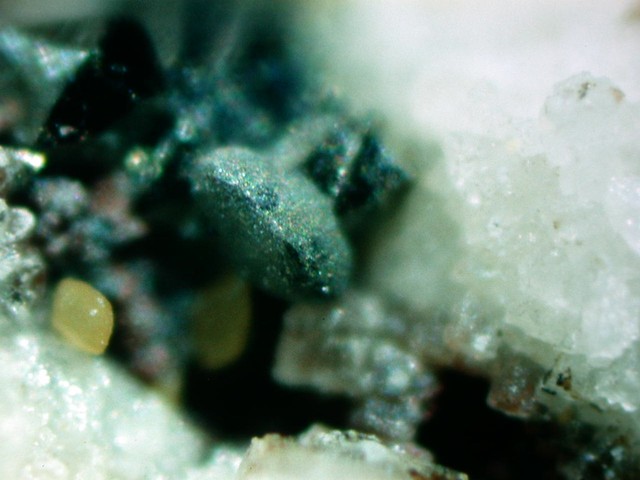 wittichenite
wittichenite Here is where it gets interesting. Due to regulations, all of the gold and other minerals were unable to be mined. The massive deposit is located under the Flambeau River and extends to the Southwest beyond the river. There were some initial discussions of rerouting the river, constructing a dam, etc., but nothing materialized in the late 1990’s. Jump ahead to around 2012. Enbridge crude oil, announces plans to upgrade their line that goes through Rusk County, WI. They also plan on constructing a new pumping station, just East of Ladysmith, along Highway 8. I traveled this road twice a day, at least 6 days per week at the time.
Initially, the construction process seems fairly straight forward. The pump station under construction can be seen from the road. Gravel trucks coming in empty and leaving with debris. Then, things changed. The view from the road was blocked off. More heavy equipment was brought in. Additional types of rock hauling trucks appeared. These were the large semi style ones. When a large group of semi’s would be leaving, the entrance to the pumping station was blocked by law enforcement and traffic on Highway 8 was stopped. There was usually a law enforcement vehicle leading the procession and one at the end. This continued for about 2 months. Why would trucks hauling debris from the construction of an oil pumping station need a law enforcement escort? They were in no danger. No violent protests going on.
The price of gold is up to $1600.00 per ounce.
Is it possible that a massive gold deposit was discovered during the pumping station construction? The pumping station is located about 5 miles from where the edge of the Flambeau mine deposit was mapped. Only a very small area of the deposit was mined. Other locals are speculating on this, including those with education/experience in the geology of the area. They have done some interpretation of geological mapping and feel this is a strong possibility.
Only wish I was better at interpreting geology maps and had more time, but I am very curious.
Link to history of Flambeau Mine: www.weismuseum.org/uploads/3/4/9/3/34934999/flambeau_revised_final_20140719.pdf
The link contains a map of the entire deposit (publicized version) that was included in the report. Page 9.
Sorry, but some of the photos I saved would not upload.











